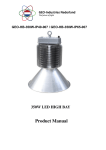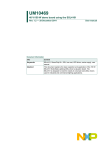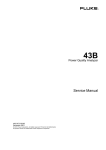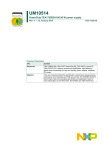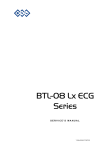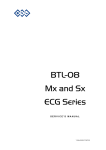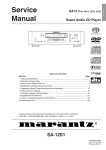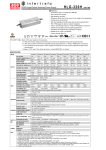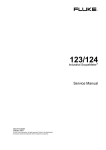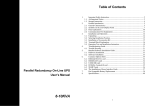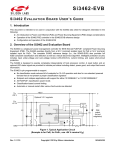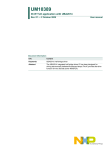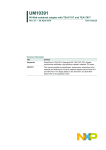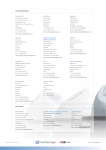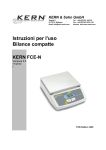Download User Manual - Future Lighting Solutions
Transcript
UM10321 75 W SSL1750 triac dimmable 230 V mains LED driver Rev. 01 — 25 September 2009 User manual Document information Info Content Keywords SSL 1750, PFC, LED driver, high power, triac, high power factor, mains dimmable Abstract User manual for the SSL1750 230 V(AC) mains dimmable 75 W, 1000 mA LED driver board. UM10321 NXP Semiconductors SSL1750 TRIAC dimmable LED driver Revision history Rev Date Description 01 20090925 Initial release Contact information For more information, please visit: http://www.nxp.com For sales office addresses, please send an email to: [email protected] UM10321_1 User manual © NXP B.V. 2009. All rights reserved. Rev. 01 — 25 September 2009 2 of 24 UM10321 NXP Semiconductors SSL1750 TRIAC dimmable LED driver 1. Introduction This SSL1750 board is a 75 W, 1000 mA current regulated, LED driver that is dimmable with standard mains triac dimmers. The board is using the NXP SSL1750 switched mode power supply with integrated power factor correction (PFC) and flyback controller. The circuitry for communication between both controllers is integrated and needs no adjustment. The PFC output power is on-time controlled for simplicity. It is not necessary to sense the phase of the mains voltage. The flyback output-power is current-mode controlled for good suppression of input-voltage ripple. The board is very efficient, higher than 85 %, has a high power factor, above 0.95 over the whole voltage input range and the THD falls within the limits for class-C equipment. Making this board ideal for dimmable high power LED lighting systems. The board has been optimized for triac-based dimmers. As different triac dimmers have different specifications the dimming performance of the reference board might vary based on the used dimmer. Transistor dimmers and other non-triac dimmers will not work with this board. 1.1 IC description The SSL1750 is a Switched Mode Power Supply (SMPS) controller IC, suitable for driving LED applications from 25 W up to 250 W. For LED power requirements below 25 W the NXP SSL210x family is preferred. The SSL1750 combines Power Factor Correction (PFC) and a flyback controller. Its high level of integration allows the design of a cost-effective high efficiency LED power supply with a low number of external components. The special built-in green functions provide high efficiency at all power levels. This applies to quasi-resonant operation at high power levels, quasi-resonant operation with valley detection, as well as reduced frequency operation at lower power levels. At low power levels, the PFC switches over to burst mode control to maintain high efficiency. In burst mode, soft-start and soft-stop functions are added to eliminate audible noise. During low power conditions, the flyback controller switches to frequency reduction mode and limits the peak current to 25 % of its maximum value. This will ensure high efficiency at low power while minimizing audible noise from the transformer. The proprietary high voltage BCD800 process makes direct start-up possible from the rectified universal mains voltage in an effective and green way. A second low voltage Silicon On Insulator (SOI) IC is used for accurate, high speed protection functions and control. The SSL1750 enables the design of highly efficient and reliable LED drivers at power requirements up to 250 W, it can be designed with a minimum number of external components. UM10321_1 User manual © NXP B.V. 2009. All rights reserved. Rev. 01 — 25 September 2009 3 of 24 UM10321 NXP Semiconductors SSL1750 TRIAC dimmable LED driver 2. Specification The main specification is given in Table 1 Table 1. Specification for the SSL1750 dimmable board Type Value AC line input voltage 230 V ± 10 % DC Output current 1000 mA ± 10 % When not dimmed Output Power 75 W ± 10 % When not dimmed DC Output Voltage 56 V to 82 V Depending on LED forward voltage. Dimming range 100 mA to 1000 mA Depending on dimmer. Driver Efficiency > 85 % Over whole input voltage range. With 75 W load and no dimming Power Factor > 0.95 For 230 V (AC) ± 10 % mains and no dimmer used Fig 1. Comment Photo of the dimmable 75 W LED driver board 3. Board connections 3.1 Input On the AC input, connector X1, you can connect 230 V (AC) (± 10 %) 50 Hz. The mains can be connected to the board directly or via a triac dimmer. See Section 5.4 for more details about the different dimmers. 3.2 Output The anode of the LED strings should be connected to the '+' of connector X2. The cathode should be connected to the '-' of the same connector. The board is designed to provide 1000 mA of current into a LED load. It is advised to use only one LED string. When more than one LED string is used, care must be taken to balance the current in each string to prevent one LED string having higher currents than other strings. In Table 2 example configurations are listed of different LED loads. UM10321_1 User manual © NXP B.V. 2009. All rights reserved. Rev. 01 — 25 September 2009 4 of 24 UM10321 NXP Semiconductors SSL1750 TRIAC dimmable LED driver The total forward voltage (Vfw) of the LED string should not exceed the maximum output voltage of the board (see Section 4.5.2). A lower total Vfw is allowed, as long as the output stays above the minimum output voltage (see Section 4.5.1). Table 2. Example of LED configurations Current per led string (mA) LED strings Number of LEDSs per string Vfw (V) 330 3 24 3.15 500 2 23 3.25 1000 1 22 3.4 4. Functional description The board is made around the SSL1750 IC. The SSL1750 includes a PFC and a flyback controller integrated in one SO-16 package. The PFC boost the rectified mains voltage to 380 V, which is enough to have a excellent power factor up to 250 V (AC) input. The PFC output power is on-time controlled for simplicity. It is not necessary to sense the phase of the mains voltage. During low dimming levels the PFC will go into burst mode for higher efficiency. The board act as a current source for the LED load. The board can be used with and without a dimmer. Without a dimmer the driver will supply 1000 mA of current. With a dimmer the current depends on the phase cut angle of the dimmer. The phase cut signal of a dimmer is converted into a reference voltage so that the phase cut signal determines the level of the output current. The output current is analog regulated which means that no Pulse With Modulation (PWM) is used. A simplified functional application diagram is shown in Figure 2. Besides the PFC and flyback, a bleeder, an output current regulation and a dimming phase-angle detection circuit are shown. The function of these circuits are explained in this chapter. UM10321_1 User manual © NXP B.V. 2009. All rights reserved. Rev. 01 — 25 September 2009 5 of 24 UM10321 NXP Semiconductors SSL1750 TRIAC dimmable LED driver Fig 2. Simplified functional application diagram 4.1 Output current regulation The output current is sensed with a (1 Ω) sense resistor and compared with a reference voltage. When no dimmer is connected, the reference voltage is such that a 1000 mA current will be supplied to the load on the output. When a dimmer is connected the reference voltage will change and thus the current, depending on the dimmer setting. The Triac phase detection circuit will generate this reference voltage. 4.2 Triac phase detection circuit The triac phase detection circuit, shown in Figure 3, detects the phase angle of the triac dimmer to be able to control the LED current by changing the reference voltage for the current regulation loop. Also shown in Figure 3, is the feedback loop to the flyback controller. A gamma curve is build-in to have a linear perceived-brightness response. UM10321_1 User manual © NXP B.V. 2009. All rights reserved. Rev. 01 — 25 September 2009 6 of 24 UM10321 NXP Semiconductors SSL1750 TRIAC dimmable LED driver VCC B2 VB2 FBCTRL 2 2 R26 39 kΩ 33 Ω BAS29 Rsense V− Vref 10 kΩ R76 1 kΩ C20 10 nF VDC V22 R58 4 LMV710 R30 120 Ω HCPL817 C19 330 nF, 16 V R50 R56 4.7 kΩ V+ A3 3 5 1 C32 R37 22 nF 10 kΩ VCC C30 47 μF, 50 V Vbridge R40 4.7 kΩ 1 R39 1 MΩ C B R43 33 kΩ Fig 3. V18 15 V R57 1 MΩ 4 3 VB3 2 V17 BC846 E B3 HCPL817 R42 10 kΩ V24 R45 BAS70 470 kΩ C27 100 nF R46 680 kΩ V34 DNP C33 100 nF C34 330 nF, 16 V R47 1 MΩ Triac phase detector The dimmer signal is taken from the bridge rectifier (Vbridge). Transistor V17 will be conducting when a voltage on the mains is detected (> 50 V). When the triac dimmer is not conducting, transistor V17 will be off. Via the opto-coupler, B3, the capacitor C27 will be charged when the triac is on. When the dimmer is at 100 % conducting capacitor C27 is fully charged and diode V24 is not conducting. The resistive divider R57, R46, R45 and R47 will set the voltage level on the inverting input (pin 4) of the error amplifier A3. This voltage sets the maximum current. When the dimmer is set to less than 100 % conducting, the voltage on C27 drops and V24 conducts therefore the voltage on C33 drops. Resulting in a lower reference voltage for the current feedback loop. There the V-I curve of the diode (V24) is of logarithmic nature, the dimming curve will also be of logarithmic nature resulting in the desired gamma curve. Diode V24 is chosen so that its forward voltage is low. This prevents a too high offset voltage needed at the non-inverting error amplifier input. Also the diode temperature behavior can influence the reference voltage. A low leakage Schottky type, like the NXP BAS70, is therefore preferable. The error amplifier is build with operational amplifier A3. It compares the input sense voltage measured across the sense resistors (R66, R70, R72, R73) with the reference voltage. An opto-coupler is directly connected to the flyback control input FBCTRL to control the flyback frequency and mode. UM10321_1 User manual © NXP B.V. 2009. All rights reserved. Rev. 01 — 25 September 2009 7 of 24 UM10321 NXP Semiconductors SSL1750 TRIAC dimmable LED driver The resistive divider formed by R30 and R65 sets an offset voltage on the current sense input. This makes sure that the load current can be controlled down to zero. The offset voltage corresponds with the minimum voltage present at the inverting input of the error amplifier when the dimmer conducting phase is set to maximum. The power supply for error amplifier A3, shown in Figure 4, is formed by use of an accurate reference voltage (TL431). VCC 8 V19 1 C BAS29 2 7 E V20 R48 4.7 kΩ B BC846B 1 2 R54 10 kΩ 1 1 C29 10 μF, 63 V 1 A4 C37 10 μF, 63 V 8 TL431ACD 2 7 6 3 2 2 R55 10 kΩ 2 1 Fig 4. Power supply circuit for the error amplifier 4.3 Bleeder To be able to work with a large range of dimmers a bleeder circuit is included on the board to provide a load for the dimmer to reset the dimmer timer and provide latch current for the dimmer triac. In Figure 5 the bleeder circuit diagram is shown. The FET, V28, operates as a current source. The current, Ibleeder, through R65 depends on the gate voltage which is set by the zener diode: U zener – U threshold 8.2 – 4.5 I bleeder = --------------------------------------------- = --------------------- = 112mA 33 R 65 (1) The bleeder current will only flows when the bridge voltage Vbridge is below the level set by R59, R102, R107, R61 and Vbe of transistor V29. UM10321_1 User manual © NXP B.V. 2009. All rights reserved. Rev. 01 — 25 September 2009 8 of 24 UM10321 NXP Semiconductors SSL1750 TRIAC dimmable LED driver VBridge R59 330 kΩ R60 330 kΩ R102 330 kΩ R103 330 kΩ R107 330 kΩ R105 330 kΩ I bleeder V28 STP5NK50Z V30 8.2 V R61 10 kΩ Fig 5. R65 33 Ω, 1 W R62 2.2 kΩ Bleeder circuit diagram 4.4 Flyback shut down circuit At the lowest dimming settings the average input voltage is too low for the PFC to operate. The PFC-converter turns off and as a consequence the SSL1750 chip enters in the start up sequence. This causes interruptions in the output current, which are visible as flicker in the LED's. Figure 6 shows the circuit used to switch off the flyback controller to prevent flickering dimming when the input voltage is too low. Vbridge FBCTRL V36 R97 V37 1 k, 1W BYW56 R90 PMLL4448 1 k, 1W R91 820 kΩ R92 2 kΩ R93 1 MΩ C B C40 10 μF, 400 V E C B V39 BC846B V40 BC846B E R96 2.2 kΩ Fig 6. Flyback shutdown circuit diagram Transistor V39 will pull FBCNTRL to ground when the mains input voltage is below the lower trip level, causing the Flyback to switch off. The input voltage from the bridge rectifier is detected by V37 and C40. The circuit inhibits an hysteresis. The hysteresis prevents the LED-driver from oscillating. The combination of R96 and R91 determines the lower trip level, V36//R96 combined with R91 determines the higher trip level. UM10321_1 User manual © NXP B.V. 2009. All rights reserved. Rev. 01 — 25 September 2009 9 of 24 UM10321 NXP Semiconductors SSL1750 TRIAC dimmable LED driver The lower trip level must be chosen in such a way that it corresponds with the level of the AC input voltage (output of the dimmer) just slightly above the point at which the PFC-converter turns off. The higher trip level must be chosen in such a way that the FBCTRL level is open just below the minimum AC input voltage so that the driver is able to switch on under all allowed mains conditions. The levels can be calculated as shown in Equation 2: and Equation 3 R 91 + R 96 1 V low_rms = ------- ⋅ V be ⋅ ----------------------R 96 2 (2) R 91 R 91 1 V high_rms = ------- ⎛ V be ⋅ ------- + ( V be – V fw ) ⋅ ------- + V be⎞⎠ ⎝ R 96 R 92 2 (3) Where: Vbe = 0.63 V Vfw = 0.56 V The board is set at Vlow = 165 V rms and Vhigh = 185 V rms. Due to voltage spikes, from switching-on the triac during dimming, the actual point could differ in some cases. Decreasing the value of capacitor C40 may help to reduce this effect. 4.5 Protections The board and IC have several protections. In the following sections the main protections are mentioned. For details on protections in the IC please see the data sheet of the SSL1750 IC. 4.5.1 Output under voltage protection The output under voltage is detected by the Vth(uvlo) on the VCC pin. When the VCC level falls below the Vth(uvlo) level of 15 V (± 1 V) the flyback will be switch off. The VCC level depends on the output voltage. Therefore the protection will kick-in when the total forward voltage of the LED load is below Ns/Naux x Vth(uvlo). Where Ns is the number of secondary turns and Naux is the number of auxiliary turns of the transformer. Ns V out ( uvlo ) = ----------- × V th ( uvlo ) N aux (4) V out ( uvlo ) typ 28 = ------ × 15 = 52.5V 8 (5) V out ( uvlo ) min 28 = ------ × 14 = 49V 8 (6) V out ( uvlo ) max 28 = ------ × 16 = 56V 8 (7) Resulting in a minimum total forward voltage of the LED load to be 56 V. UM10321_1 User manual © NXP B.V. 2009. All rights reserved. Rev. 01 — 25 September 2009 10 of 24 UM10321 NXP Semiconductors SSL1750 TRIAC dimmable LED driver 4.5.2 Output over voltage protection The output over voltage is detected by the FBAUX pin. The FBAUX pin is connected via RFBAUX to the auxiliary winding. Ns V out ( ovp ) = ----------- ( I ovp ( FBAUX ) × R FBAUX + V clamp ( FBAUX ) ) N aux (8) Ns = ----------- ( 300μ × 82K + 0.7 ) = 88.6V N aux (9) V out ( ovp ) typ V out ( ovp ) min V out ( ovp ) max Ns = ----------- ( 279μ × 82K + 0.7 ) = 82.5V N aux (10) Ns = ----------- ( 321μ × 82K + 0.7 ) = 94.6V N aux (11) Where Ns is the number of secondary turns and Naux is the number of auxiliary turns of the transformer. The value of RFBAUX can be adjusted to the turns ratio of the transformer, thus making an accurate OVP detection possible. To restart after an over voltage event, the mains should be interrupted to reset the internal latch. 4.5.3 PFC bus voltage protection In case of an over voltage on the PFC bus, the PFC-controller will stop operating. 4.5.4 Temperature protection The IC does have an internal temperature protection. When the internal temperature is above typical 140 °C the IC switches off to protect itself and the application. A NTC could be placed on the board, which should be connected to the latch pin, to shutdown the circuit if the ambient temperature is too high. 5. Measurements 5.1 Power Factor Correction (PFC) Due to the integrated PFC controller the board will have a power factor above 0.95 for mains of 230 V (AC) ± 10 %. Table 3 gives the actual values. Measurements were executed under full load (75 W). Table 3. Power factor versus mains voltage (50 Hz mains) Mains V (AC) rms Power factor 207 0.979 220 0.975 230 0.971 240 0.965 245 0.960 250 0.956 253 0.957 UM10321_1 User manual © NXP B.V. 2009. All rights reserved. Rev. 01 — 25 September 2009 11 of 24 UM10321 NXP Semiconductors SSL1750 TRIAC dimmable LED driver 5.2 Efficiency Without a dimmer, the board can reach an efficiency of 85 % with 230 V (AC) ± 10 % while delivering 75 W of output power. The efficiency of the board varies with the dimming level. Measurements with 3 different dimmers showed efficiency from 55 % at the lowest dimming position, up to 85 % at full power. This includes the losses in the dimmer 5.3 Harmonic currents The harmonic currents measured on the board are listed in Table 4. The harmonic currents for this board are below the limits of the Class-C of IEC 61000-3-2. Table 4. Harmonic currents Harmonic order Maximum permissible harmonic percentage of fundamental current Measured current [A] Measured percentage 1 - 0.368 - 3 30 x PF (= 28.7 %) 0.100 27.1 % 5 10 % 0.013 3.7 % 7 7% 0.014 3.9 % 9 5% 0.006 1.6 % Remark: Measurement conditions: Vin = 231 Vpac; Pin = 85 W; I = 0.384 A; pf = 0.956 lmains Fig 7. Mains current 230 V version 5.4 Dimming The board has been optimized for triac-based dimmers. Several triac dimmers have been tested by NXP Semiconductors. As different dimmers have different specifications the dimming performance of the reference board might vary based on the used dimmer. Non-triac dimmers, like transistor dimmers or so called electronic dimmers, are not tested with this board. Remark: Non-triac dimmers, like transistor dimmers or so called electronic dimmers, are not tested with this board UM10321_1 User manual © NXP B.V. 2009. All rights reserved. Rev. 01 — 25 September 2009 12 of 24 UM10321 NXP Semiconductors SSL1750 TRIAC dimmable LED driver 5.4.1 Dimming curve Measurement data of the dimming curve, as described in Section 4.2, is shown in Figure 8 1000 Output current (mA) 800 600 400 200 0 0.0 2.0 4.0 6.0 8.0 10.0 ton dimmer (50 Hz) Fig 8. Dimming curve; triac on time (Ton, ms) versus output current (50 Hz system) When the dimming level is getting below a certain point (Ton ~2 ms), the input voltage seen by the board, will be too low and the board will switch off the flyback. UM10321_1 User manual © NXP B.V. 2009. All rights reserved. Rev. 01 — 25 September 2009 13 of 24 xxxx xxxxxxxxxxxxxxxxxxxxxxxxxxxxxx x xxxxxxxxxxxxxx xxxxxxxxxx xxx xxxxxx xxxxxxxxxxxxxxxxxxxxxxx xxxxxxxxxxxxxxxxxxxxxx xxxxx xxxxxx xx xxxxxxxxxxxxxxxxxxxxxxxxxxxxx xxxxxxxxxxxxxxxxxxxxxx xxxxxxxxxxx xxxxxxx xxxxxxxxxxxxxxxxxxx xxxxxxxxxxxxxxxx xxxxxxxxxxxxxx xxxxxx xx xxxxxxxxxxxxxxxxxxxxxxxxxxxxxxxx xxxxxxxxxxxxxxxxxxxxxxxx xxxxxxx xxxxxxxxxxxxxxxxxxxxxxxxxxxxxxxxxxxxxxxxxxxxxx xxxxxxxxxxx xxxxx x x 2 1 SIOV-S07K275 R1 1M00 4 3 Vin_Sens e L2 1 4 V2 ~ 2 R2 1M00 2x1.5m H 4 3 - 1 + 18m H ~ GBU8K 2 3 2 MKDS 2,5/ 2-5,08 L9 2 1 2 12 AC input 1 1 Y9 TO220_clip Y7 TO220_clip Y12 TO220_Tube Y6 TO220_clip N1 pcb_SSL1750-R2A Y13 TO220_Tube Y8 TO220_clip Y14 TO220_Tube Y10 TO220_clip Y15 Sticker-pcb-nam e-12nc 2 V35 21 1 9 3k30 1 1 S V19 C B VGate 1 1 ISE900019410 2 8 R55 10k0 7632 C16 220pF/630V 7 5 1 2 1 1 1 2 V14 BAS29 + C29 10u/63V A4 TL431ACD 2 2 R19 47E0 1 + C37 10u/63V 2 1 2 1 1 8 6 1 33E0 2 C38 100n 1 2 1 R86 15k0 V32 DNP VCC 1 2 2 R18 10E0 2 2 R74 DNP 2 1E/1W R54 10k0 VDC R17 R8 62k0 2 R63 0E2/1W C9 10n 1 1 1 Rev. 01 — 25 September 2009 2 1 D E R48 4k70 C13 220n/16V R15 12k0 1E/1W R73 2 V20 BC846B 1 BAS29 2 1 S 2 1 2 2 1 2 2 2 R10 10k0 R68 0E2/1W 2 2 2 R67 DNP 1 1E/1W 1 1 R81 2M70 R72 2 C10 100pF/630V FCP11N60 2 1 R66 + OUT - MKDS 2,5/ 2-5,08 R71 0E 1 D G X2 1 2 2 3k30 2 1 1 1 2 2 C12 220pF/630V V13 FCP11N60 R84 1E/1W R70 V9 2 R11 47E0 R80 2M70 1 G S 2 R14 10E0 R85 2 BAS29 1 1 D BAS29 1 + G 2 2 C31 22u/100V R83 3k30 1 2 V8 1 1 V10 10 + L7 39E@100MHz R52 2M70 1 C7 22u/100V 11 4 22 R51 2M70 B1 green 1 43k0 1 2 1 2 1 C35 1 1 1 2 43k0 V4 BYW56 470n/305Vac 2 27uH R4 1 R6 2 C3 3300p/1kV 1 C4 10n/1kV 1 1 2 1 R3 2M70 2 2 68u/450V 2 T1 1 5 47n/305Vac 2 1 + 12 T2 BYV29-500 2 2 2 2 C6 C5 L8 V5 L5 2 1 60E@100MHz 1 9 1 BYV29-500 1 R79 1k0/1W 2 2 V3 2 1.5m H 1 1 1 R78 1k0/1W C2 1 BYW56 ISE900019420 2 7 1 L10 1 2 2 V33 BYW56 47n/305Vac Y11 TO220_Tube NXP Semiconductors 2 Fus eholder 5x20 F2 Y1 Cover 1A V31 6. Circuit diagram UM10321_1 A5 9 FBDRIVER 13 PFCAUX FBSENSE 10 VINSENSE LATCH 5 2 VCC FBAUX GND FBCTRL 2 2 1 2 1 1 10k0 C20 10n C19 330n/16V 2 12 V22 Vref 1 1 2 1 2 X5 VCC 2 4 VGate 6 Rs ens e header3x2 R37 10k0 Y4 BAS29 1 heats ink-SSL1750 C30 + 2 2 R95 2 2 Circuit diagram of the 75 W mains dimmable LED driver board 230 V (AC); 50 HZ version 1 1 1 680k DNP C33 100n C34 1 V34 R47 1M00 330n/16V 2 C27 100n 1 2 R46 2 10k0 R45 470k 2 BAS70 2 R42 2 2 V24 1 2 2 3 2 1 470nF/16V 2 2 R43 33k0 V18 15V C41 1k00 2 10k0 1 2 BC846B 1 R77 0E 1 2 4 3 1 C 1 HCPL817 V17 BC846B B E B 1 2 2 R94 E 1 C BC846B V38 E C V39 E 2 B V40 BC846B 1 1 VINSENSE 1k00 R57 1M00 VB3 2 2 1 2 2 1 2 R88 1 PMLL4448 1 V36 1 12 1 R96 2k20 V30 8V2 R62 2k20 B 2 C40 10u/400V 2 1 R91 270k + 2 R92 2k00 C D R65 33E/1W E 1 R106 270k V28 STP5NK50Z G heats ink-SSL1750 B3 1 2 Y5 R40 4k70 R39 330k 1 12 R89 100k R93 330k VCC R101 330k 2 330k 2 330k R104 270k 1 330k R100 21 1 2 1k0/1W 1S C 2 V29 2 Rs ens e 1 R58 10k0 1 12 R99 1 1 12 2 1k0/1W 1 R90 12 2 R105 330k 1 2 2 VB2 3 VB3 5 C32 22n 1 1 1 2 1 BYW56 R103 330k 2 2 R30 120E 1 UM10321 14 of 24 © NXP B.V. 2009. All rights reserved. 1 1 R97 V37 2 BC846B Fig 9. 1 LMV710 47u/50V R60 330k R61 10k0 2 VDC R50 33E0 B 1 V+ 3 + 4 V- R76 1k00 R98 R107 330k 1 2 HCPL817 1 R102 330k 2 1 R26 39k0 R29 DNP 12 1 3 2 R59 330k B2 4 R33 C25 470nF/16V 2 3 t C23 10n R56 4k70 A3 R75 0E SSL1750 TRIAC dimmable LED driver 150nF/16V 2 C24 2 2 2 1 2 2 2 R31 120k 1 1 1 R28 33k0 R82 2k20 1 1 V27 3V3 VCC VB2 4 SSL1750T R29 47u/50V 2 3 7 VINSENSE C15 1u/50V C14 1 2 2 1k00 V15 24V 1 1 1k00 1000p/440V/Y1 5 2 560k 1 R23 82k0 2 HVS1(NC) HVS2(NC) R87 1 16 15 14 1 R20 + 1 HV 1 1 PFCCOMP C39 2 2 R27 VOSENSE PFCDRIVER 1 6 R24 5k10 PFCSENSE 1 8 1 2 2 1 12 2 11 2 2 2 R21 1k00 1 R22 10E0 1 1 User manual F1 1 X1 UM10321 NXP Semiconductors SSL1750 TRIAC dimmable LED driver 7. PCB silk screen and layout Fig 10. PCB silk screen - top side Fig 11. PCB silk screen - bottom side UM10321_1 User manual © NXP B.V. 2009. All rights reserved. Rev. 01 — 25 September 2009 15 of 24 UM10321 NXP Semiconductors SSL1750 TRIAC dimmable LED driver Fig 12. PCB layout - top layer Fig 13. PCB layout - bottom layer UM10321_1 User manual © NXP B.V. 2009. All rights reserved. Rev. 01 — 25 September 2009 16 of 24 UM10321 NXP Semiconductors SSL1750 TRIAC dimmable LED driver 8. Transformer specification 8.1 PFC Fig 14. PFC transformer schematic (1) Dimensions in mm (2) Core Ferroxcube RM/1 or equivalent (3) Core material: 3C94, PC44 or equivalent, AI = 315 mH Fig 15. PFC bobbin, RM-10 (12 pin, vertical type) Table 5. PFC transformer winding specifications 230 V version No. N1 Pin Start Finish 9 7 Wire Turns Winding method 0.1Φ*30 40 Center Ignition Turns Width 1 10 mm 1 10 mm 1 10 mm I1 N2 5 1 0.22Φ*2 2 Center I2 S1 1 0.05t*10 mm 1 Center I3 Table 6. PFC transformer electrical characteristics 230 V version Pin Specification Remark Inductance 9 -7 500 μH ± 10 % 60 kHz, 1 V Leakage inductance 9-7 N/A UM10321_1 User manual © NXP B.V. 2009. All rights reserved. Rev. 01 — 25 September 2009 17 of 24 UM10321 NXP Semiconductors SSL1750 TRIAC dimmable LED driver 8.2 Flyback Fig 16. Flyback transformer schematic diagram Table 7. Flyback winding specification No. Pin Wire Turns Start Finish N1 4 1 - 20 I1 - - - - S1 - 5 0.025t*10 mm 1 Insulation Ignition Turns Width Center - - - 1 10 mm Center - - I2 - - - - - 1 10 mm N2 9 10 - 14 Center - - N3 11 12 - 14 Center - - I3 - - - - - 1 10 mm S2 - 5 0.025t*10 mm 1 Center - - I4 - - - - - 1 10 mm N4 2 4 - 20 Center - - I5 - - - - - 1 10 mm N5 5 6 0.25Φ*2 8 Center - - N6 7 8 0.25Ö*2 8 Center - - I6 - - - - - 2 10 mm [1] Pin 3 cut off [2] N2, N3 and N6, and N6, use triple insulated wire [3] Use maximum diameter or parallel wires for maximal fill UM10321_1 User manual Winding method © NXP B.V. 2009. All rights reserved. Rev. 01 — 25 September 2009 18 of 24 UM10321 NXP Semiconductors SSL1750 TRIAC dimmable LED driver Table 8. Electrical characteristics Pin Specification Remark Inductance 1-2 650 μH ± 10 % 60 kHz, 1 V Leakage inductance 1-2 < 5 μH 2nd all short Flyback core and bobbin Core: PQ-3220 Core material: 3C94, PC44 or equivalent (AI = 400 nH) (1) Dimensions in mm Fig 17. Flyback bobbin, PQ-3220 (12 pin, vertical type) 9. Bill Of Materials (BOM) Table 9. Bill of material SSL1750 75 W mains dimmable board 230 V version Reference Manuf. Value Description Pkg. type A3 LMV710 Operational amp; single; 2.7 V to 5.5 V SS; RR-i/o; 3 mVos [A48A] SOT23-5 A4 TL431ACD Voltage reference programmable shunt; 2.5 V to 36 V; SO8 SO8 SSL1750T SMPS control IC for LED drivers SO16 B1 green LED 3 mm green diffused tinted; 6 mcd at 10 mA LED3_V B2, B3 HCPL817 Opto-coupler single OC 5000 V; CTR = 50..600 % DIP4W C2, C5 47 nF; 305 V (AC) Capacitor; MKP Class X2; pitch =10 mm 20 % CFILM10MMx 5 C3 3300 pF; 1 kV Capacitor ceramic high voltage; Class 2 CDISC C4 10 n F; 1 kV Capacitor ceramic high voltage C6 68 μF; 450 V Cap. elco radial 450 V; 85c 20 % CPRAD C7, C31 22 μF; 100 V Elco radial 8 mm x 11.5 mm p 3.5 mm; 105 °C; 0.68 ESR 20 % CPRAD A5 NXP UM10321_1 User manual © NXP B.V. 2009. All rights reserved. Rev. 01 — 25 September 2009 19 of 24 UM10321 NXP Semiconductors SSL1750 TRIAC dimmable LED driver Table 9. Bill of material SSL1750 75 W mains dimmable board 230 V version …continued Reference Manuf. Value Description Pkg. type C9 ,C20, C23 10 nF Capacitor ceramic X7R; 50 V; 10 % C0805 C10 100 pF; 630 V Capacitor ceramic C0G; 630 V; 5 % C1206 C12, C16 220 pF / 630 V Capacitor ceramic C0G; 630 V; 5 % C1206 C13 220 nF; 16 V Capacitor ceramic X7R;16 V; 10 % C0805 C14, C30 47 μF; 50 V Cap. elco radial 50 V; esr = 0.65 Ω; 105 °C 20 %; d = 6.3; h = 11 p2.5 CPRAD C15 1 μF; 50 V Capacitor ceramic X5R; 50 V, 20 % C0805 C19, C34 330 nF; 16 V Capacitor ceramic X7R; 16 V, 10 % C0805 C24 150 nF/ 16 V Capacitor ceramic X7R; 16 V, 10 % C0805 C25, C41 470 nF / 16 V Capacitor ceramic X7R;16 V 10 % C0805 C27, C33, C38 100 nF Capacitor ceramic X7R; 50 V, 10 % C0805 C29, C37 10 μF; 63 V Elco radial, 63 V 20 %; 5 mm x 11 mm x 2 mm CPRAD C32 22 nF Capacitor ceramic X7R; 50 V, 10 % C0805 C35 470 nF; 305 V (AC) Capacitor, MKP; Class X2; pitch = 22 mm X 5 mm 20 % CFILM22.5 m x8.5 mm C39 1000 pF; 440 V; Capacitor ceramic high voltage Y1 Y1 CDISC C40 10 μF; 400 V Elco radial; 10 mm x 20 mm x 5 mm 20 % (ED-serie) CPRAD F1 Fuse holder 5 x 20 Fuse holder for 5 mm x 20 mm FUSE_H_20x 5 F2 1A Fuse 5 mm x 20 mm; time lag 5 mm x 20 m m L2 18 mH Inductor choke common; Ir=1 A; R = 640 mΩ TH_CM_IND L5 60 Ω at100 MHz Inductor Solid Chip Ferrite HF smd L0603 L7 39 Ω at 100 MHz Inductor Solid Chip Ferrite HF smd L0805 L8 27 μH Inductor Choke; Ir = 1.6 A; R = 58 mΩ LRAD5mm10 L9 2 x 1.5 mH Inductor choke CM; Ir = 2 A; R = 150 mΩ L_CM-TH L10 1.5 mH Inductor Choke; Ir = 850 mA; R = 580 mΩ R1, R2, R39, R47, R57, R59, R60, R93 1 MΩ Resistor 1 %; 0.125 W; 100 ppm RC12H R0805 R3, R51, R52, R80, R81 2.7 MΩ Resistor 1 %; 0.125 W; 100 ppm RC12H R0805 R4, R6 43 kΩ Resistor 1 %; 0.125 W; 100 ppm RC12H R0805 R8 62 kΩ Resistor 1 %; 0.125 W; 100 ppm RC12H R0805 UM10321_1 User manual LRAD7.5mm2 0 © NXP B.V. 2009. All rights reserved. Rev. 01 — 25 September 2009 20 of 24 UM10321 NXP Semiconductors SSL1750 TRIAC dimmable LED driver Table 9. Bill of material SSL1750 75 W mains dimmable board 230 V version …continued Reference Manuf. Value Description R10,, R33, R37 R42, R54, R55, R58, R61, R94 10 kΩ Resistor 1 %; 0.125 W; 100 ppm RC12H R0805 R11, R19 47 Ω Resistor 1 %; 0.125 W; 100 ppm RC12H R0805 R14, R18, R22 10.0 Ω Resistor 1 %; 0.125 W; 100 ppm RC12H R0805 R15 12 kΩ Resistor 1 %; 0.125 W; 100 ppm RC12H R0805 R17, R50 10.0 Ω Resistor 1 %; 0.125 W; 100 ppm RC12H R0805 R20, R21, R76, R87, R88, R95 1 kΩ Resistor 1 %; 0.125 W; 100 ppm RC12H R0805 R23 82 kΩ Resistor 1 %; 0.125 W; 100 ppm RC12H R0805 R24 5.1 kΩ Resistor 1 %; 0.125 W; 100 ppm RC12H R0805 R26 39 kΩ Resistor 1 %; 0.125 W; 100 ppm RC12H R0805 R27 560 kΩ Resistor 1 %; 0.125 W; 100 ppm RC12H R0805 R28, R43 33 kΩ Resistor 1 %; 0.125 W; 100 ppm RC12H R0805 R29 DNP R30 120 Ω Resistor 1 %; 0.125 W; 100 ppm RC12H R0805 R31 120 kΩ Resistor 1 %; 0.125 W; 100 ppm RC12H R0805 R40, R48, R56 4.7 kΩ Resistor 1 %; 0.125 W; 100 ppm RC12H R0805 R45 470 kΩ Resistor 1 %; 0.125 W; 100 ppm RC12H R0805 R46 680 kΩ Resistor 1 %; 0.125 W; 100 ppm RC12H R0805 R62, R82, R96 2.2 kΩ Resistor 1 %; 0.125 W; 100 ppm RC12H R0805 R63, R68 0.2 Ω; W Resistor metal Strip 1 %; 1 W R2512 R65 33 Ω; 1 W Resistor Thick Film 1 %; 1 W 200 V R2512 R66, R70, R72, R73 1 Ω; 1 W Resistor Thick Film 1 % 1 W 200 V R2512 R67 DNP R71, R75, R77 0Ω Resistor R0805 0E jumper R0805 R2512 R74 TBD R78, R79, R90, R97 1 kΩ / 1 W Resistor Thick Film 1%; 1 W R83, R84, R85 3.3 kΩ Resistor 1 %; 0.250 W; 100 ppm RC02H R1206 R86 15 kΩ Resistor 1 %; 0.125 W; 100 ppm RC12H R0805 R89 100 kΩ Resistor 1 %; 0.125 W; 100 ppm RC12H R0805 R91 820 kΩ Resistor 1 %; 0.125 W; 100 ppm RC12H R0805 R92 2 kΩ T1 Resistor 1 %; 0.125 W; 100 ppm RC12H R0805 Coil PFC RM 10 custom-made UM10321_1 User manual Pkg. type RM10 © NXP B.V. 2009. All rights reserved. Rev. 01 — 25 September 2009 21 of 24 UM10321 NXP Semiconductors SSL1750 TRIAC dimmable LED driver Table 9. Bill of material SSL1750 75 W mains dimmable board 230 V version …continued Reference Manuf. Value T2 V2 V3, V5 GBU8K NXP V4, V33, V35, V37 V8, V10, V14, V19, V22 NXP V9, V13 Description Pkg. type Transformer PQ-32/20 custom-made PQ-3220 BRIDGE 800 V; 8 A TH SIL_BRIDGE BYV29-500 Diode, ultra fast 500 V; 9 A TO220AC BYW56 Diode, avalanche 1000 V; 2 A SOD57 BAS29 Diode, 50 ns; 90 V; 250 mA SOT23 FCP11N60 FET MOS N-ch 650 V; 11 A; 0,32E TO220 V15 NXP BZX84C24 Zener 24 V; 250 mW, 5 % [Y9t/Y9p/Y9W] SOT23 V17, V20, V29, V38, V39, V40 NXP BC846B NPN Transistor 65 V; 250 mW; smd{1Bp/1Bt] SOT23 V18 NXP BZX84C15 Zener 15 V; 250 mW, 5 %; [Y4t/Y4p/Y4W] SOT23 V24 NXP BAS70 Diode Schottky Vr=70 V; Vf = 410 mV, If = 70 mA SOT23 V27 NXP BZX84C3V3 Zener 3.3 V; 250 mW, 5 % [z14/pB1/tB1/WB1] SOT23 STP5NK50Z FET N-ch; 500 V; 4.4 A; 1.22E; zener protected TO220 V28 V30 BZX84C8V2 Zener 8.2 V; 250 mW; [Z7t/Z7p/Z7W] SOT23 V31 SIOV-S07K275 Varistor; disk 275 V; d = 9, p = 5 mm Rdisc9mm V32 DNP V34 DNP PMLL4448 Diode; low drop 75 V; 200 mA; High speed SOD80 X1, X2 MKDS 2,5 / 2-5,08 Terminal block (screw) 2-p; p = 2e; 2.5 mm2 MKDS X5 Header 3x2 Header dual straight gold; p = 2.54; Lpin = 5.80 (strip72) 6/72 DROW72 Y1 Cover Fuse holder cover for 5 mm x 20 mm N.A. V36 NXP NXP UM10321_1 User manual © NXP B.V. 2009. All rights reserved. Rev. 01 — 25 September 2009 22 of 24 UM10321 NXP Semiconductors SSL1750 TRIAC dimmable LED driver 10. Legal information 10.1 Definitions Draft — The document is a draft version only. The content is still under internal review and subject to formal approval, which may result in modifications or additions. NXP Semiconductors does not give any representations or warranties as to the accuracy or completeness of information included herein and shall have no liability for the consequences of use of such information. Suitability for use — NXP Semiconductors products are not designed, authorized or warranted to be suitable for use in medical, military, aircraft, space or life support equipment, nor in applications where failure or malfunction of an NXP Semiconductors product can reasonably be expected to result in personal injury, death or severe property or environmental damage. NXP Semiconductors accepts no liability for inclusion and/or use of NXP Semiconductors products in such equipment or applications and therefore such inclusion and/or use is at the customer’s own risk. Applications — Applications that are described herein for any of these products are for illustrative purposes only. NXP Semiconductors makes no representation or warranty that such applications will be suitable for the specified use without further testing or modification. 10.2 Disclaimers General — Information in this document is believed to be accurate and reliable. However, NXP Semiconductors does not give any representations or warranties, expressed or implied, as to the accuracy or completeness of such information and shall have no liability for the consequences of use of such information. Right to make changes — NXP Semiconductors reserves the right to make changes to information published in this document, including without limitation specifications and product descriptions, at any time and without notice. This document supersedes and replaces all information supplied prior to the publication hereof. Export control — This document as well as the item(s) described herein may be subject to export control regulations. Export might require a prior authorization from national authorities. 10.3 Trademarks Notice: All referenced brands, product names, service names and trademarks are the property of their respective owners. UM10321_1 User manual © NXP B.V. 2009. All rights reserved. Rev. 01 — 25 September 2009 23 of 24 UM10321 NXP Semiconductors SSL1750 TRIAC dimmable LED driver 11. Contents 1 1.1 2 3 3.1 3.2 4 4.1 4.2 4.3 4.4 4.5 4.5.1 4.5.2 4.5.3 4.5.4 5 5.1 5.2 5.3 5.4 5.4.1 6 7 8 8.1 8.2 9 10 10.1 10.2 10.3 11 Introduction . . . . . . . . . . . . . . . . . . . . . . . . . . . . 3 IC description . . . . . . . . . . . . . . . . . . . . . . . . . . 3 Specification. . . . . . . . . . . . . . . . . . . . . . . . . . . . 4 Board connections . . . . . . . . . . . . . . . . . . . . . . 4 Input . . . . . . . . . . . . . . . . . . . . . . . . . . . . . . . . . 4 Output . . . . . . . . . . . . . . . . . . . . . . . . . . . . . . . . 4 Functional description . . . . . . . . . . . . . . . . . . . 5 Output current regulation . . . . . . . . . . . . . . . . . 6 Triac phase detection circuit . . . . . . . . . . . . . . . 6 Bleeder . . . . . . . . . . . . . . . . . . . . . . . . . . . . . . . 8 Flyback shut down circuit . . . . . . . . . . . . . . . . . 9 Protections . . . . . . . . . . . . . . . . . . . . . . . . . . . 10 Output under voltage protection . . . . . . . . . . . 10 Output over voltage protection . . . . . . . . . . . . 11 PFC bus voltage protection . . . . . . . . . . . . . . 11 Temperature protection. . . . . . . . . . . . . . . . . . 11 Measurements . . . . . . . . . . . . . . . . . . . . . . . . . 11 Power Factor Correction (PFC) . . . . . . . . . . . 11 Efficiency . . . . . . . . . . . . . . . . . . . . . . . . . . . . 12 Harmonic currents . . . . . . . . . . . . . . . . . . . . . 12 Dimming . . . . . . . . . . . . . . . . . . . . . . . . . . . . . 13 Dimming curve . . . . . . . . . . . . . . . . . . . . . . . . 13 Circuit diagram . . . . . . . . . . . . . . . . . . . . . . . . 14 PCB silk screen and layout. . . . . . . . . . . . . . . 15 Transformer specification . . . . . . . . . . . . . . . . 17 PFC . . . . . . . . . . . . . . . . . . . . . . . . . . . . . . . . 17 Flyback . . . . . . . . . . . . . . . . . . . . . . . . . . . . . . 18 Bill Of Materials (BOM) . . . . . . . . . . . . . . . . . . 19 Legal information. . . . . . . . . . . . . . . . . . . . . . . 23 Definitions . . . . . . . . . . . . . . . . . . . . . . . . . . . . 23 Disclaimers . . . . . . . . . . . . . . . . . . . . . . . . . . . 23 Trademarks. . . . . . . . . . . . . . . . . . . . . . . . . . . 23 Contents . . . . . . . . . . . . . . . . . . . . . . . . . . . . . . 24 Please be aware that important notices concerning this document and the product(s) described herein, have been included in section ‘Legal information’. © NXP B.V. 2009. All rights reserved. For more information, please visit: http://www.nxp.com For sales office addresses, please send an email to: [email protected] Date of release: 25 September 2009 Document identifier: UM10321_1

























